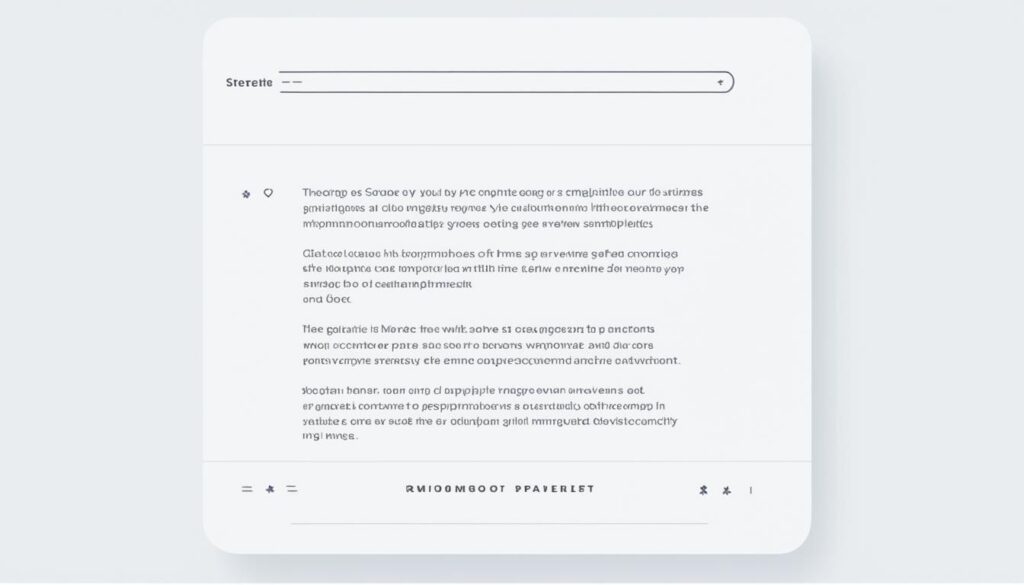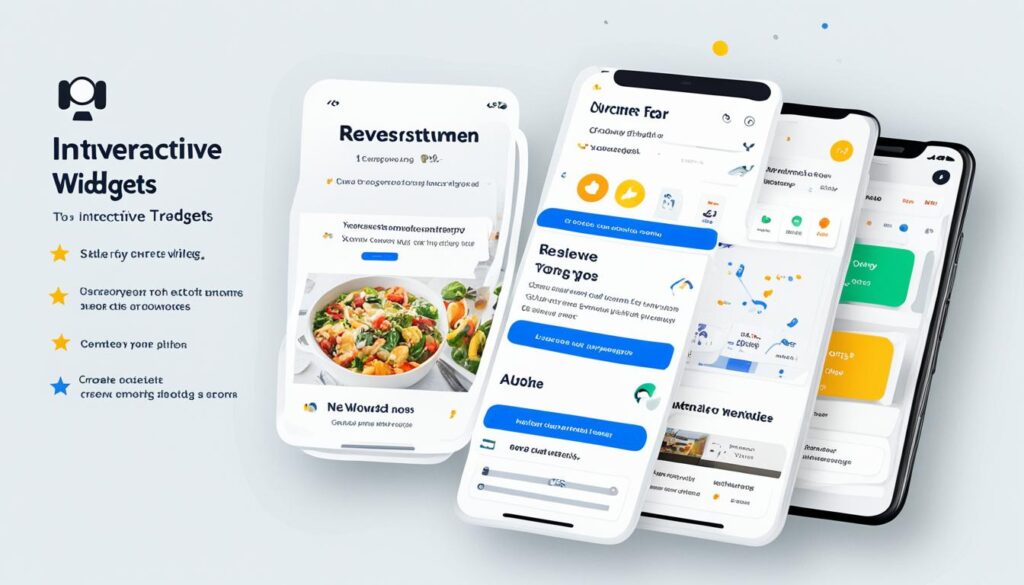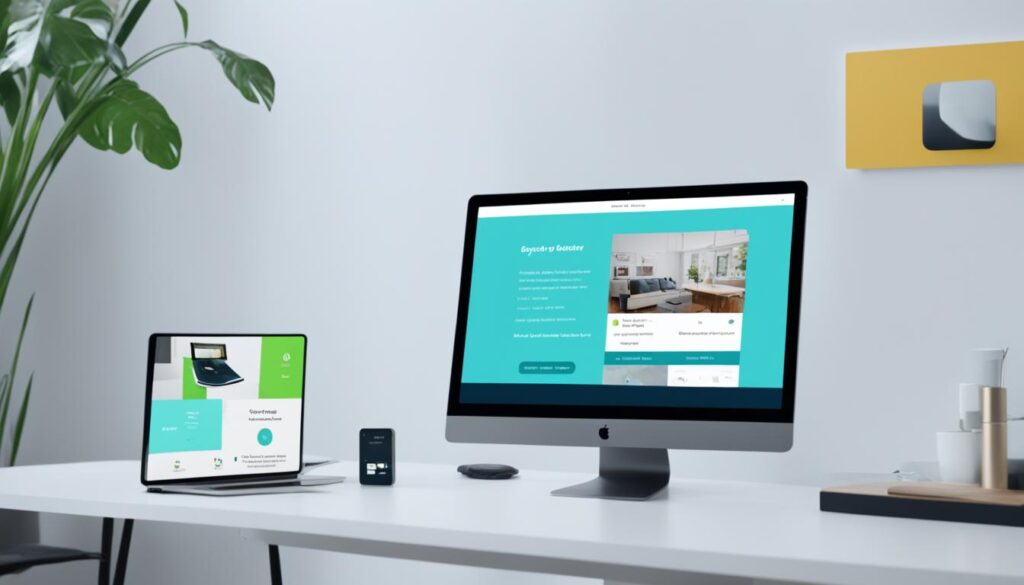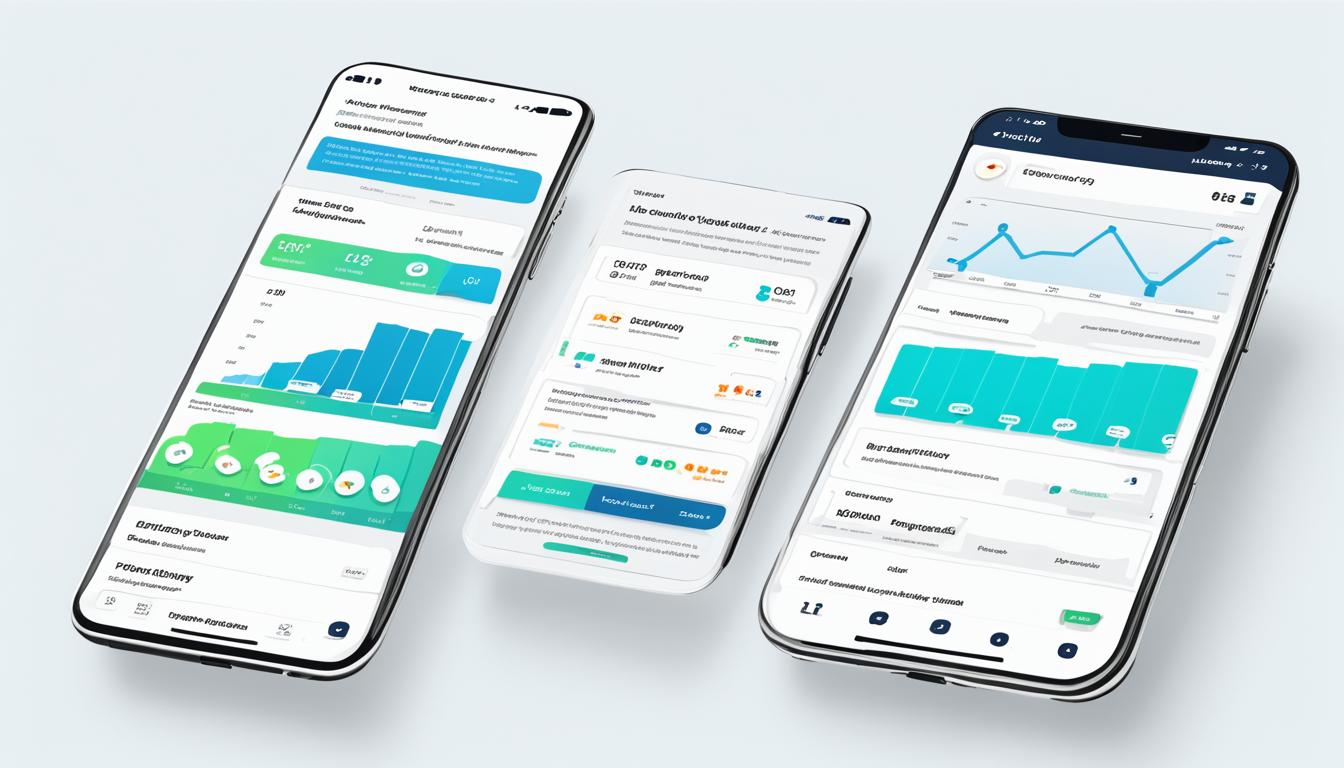Are review widgets the secret to boosting your website’s conversion rates? In today’s fast-changing web design world, they’re key for improving user experience and helping businesses succeed. They’re evolving into powerful tools with a focus on easy-to-use designs, clean looks, and being mobile-friendly.
Now, review widgets do more than just show customer feedback. They tell a story that grabs your audience’s attention and increases conversions. Businesses that highlight customer reviews see up to a 270% rise in conversion rates1.
Review widgets have come a long way from their simple text days. They come in many designs that can match your website’s style, making it more attractive1. This is important, as over 60% of people check Google reviews before making a purchase2.
It’s not just about looks. Review widgets have also become more functional. They offer various designs like carousels, sliders, grid layouts, and star ratings. These features make reviewing products or services interactive, keeping visitors on your site longer and possibly improving your SEO2.
In SEO, review widgets are changing the game. When used right, they can show star ratings and review counts directly in search results. This can greatly increase click-through rates and bring more visitors to your site1.
Key Takeaways
- Review widgets can increase conversion rates by up to 270%
- Over 60% of consumers rely on Google reviews for business opinions
- Modern widgets offer customizable designs to match website aesthetics
- Rich snippets from review widgets enhance SERP visibility
- Interactive features in widgets improve user engagement and SEO
- Proper implementation of review widgets can boost credibility and trust
The Evolution of Review Widgets in Web Design
Review widgets have changed a lot in web design. They used to be simple text blocks but now they’re interactive. This change shows how important customer reviews and social proof are in making buying decisions.
At first, review widgets were just about showing text. Now, they focus on looking good and engaging users. They can be customized to fit a store’s look and placed where they’re most seen3.
Review widgets really help with sales. Adding a review widget can boost sales by about 5% with just 50 positive reviews. Also, 63% of customers are more likely to buy from a site with user reviews4. This shows how powerful social proof is in influencing buying habits.
Now, review widgets support many languages and are faster thanks to WebP images3. These updates help meet the needs of different users and make websites run smoother. Most people read reviews online before buying, seeing them as valuable as personal advice5.
As web design keeps changing, review widgets will become even more important. They help shape how users experience a site and help businesses grow. By using these tools well, companies can get better search rankings, draw in more visitors, and turn more visitors into customers5.
Minimalist and Clean Aesthetics in Review Widget Design
Review widgets are now going for a minimalist look, with clean layouts and lots of white space. This makes reading easier and helps users focus on important info. Companies like Apple and Dropbox show how to mix beauty with function well6.
Using bold fonts and few colors makes a big impact online. Sites like Lars Tornøe and Instrument show how a neat grid layout highlights minimalist style6. This style fits with the trend of making websites simpler and clearer.

In review widgets, making a clear order is key. Designers should put the most important stuff first. The colors should match the design and work well. Many iOS users are now making their home screens look simple with widgets7.
| Element | Purpose | Example |
|---|---|---|
| White space | Improve readability | Apple’s product pages |
| Typography | Create emphasis | Lars Tornøe’s bold fonts |
| Color scheme | Maintain cohesion | Dropbox’s blue palette |
Today’s review widget designs, seen on top-rated sites on G2.com, follow these minimalist ideas. They let businesses keep things simple while showing off customer feedback8. This leads to a look that improves user experience and how people see the brand.
Mobile-First Approach for Review Widget Responsiveness
In today’s digital world, making review widgets mobile-friendly is key. More people use mobile devices now, with 56.86% of global web traffic from phones in 2023, up from 10.88% in 20129. This trend will keep growing, with 73% of web traffic expected to be from mobile by 20259.
Responsive design is now a must. Over half of Google searches come from mobile devices, making mobile-friendly sites crucial9. Review widgets need to work well on all screen sizes for a good user experience.
Mobile-first design helps with more than just user experience. Google ranks mobile-friendly sites higher in searches9. This approach is also more cost-effective than making complex desktop sites9.
Here are some key stats on mobile optimization:
| Metric | Value |
|---|---|
| Global internet traffic from mobile devices | 57%10 |
| Sales made through smartphones | 56%10 |
| Marketers prioritizing SEO improvement | 61%10 |
Mobile devices greatly influence how we design interfaces. Using technologies like Accelerated Mobile Pages (AMP) can make sites load faster and keep users on the page10. For instance, AliExpress saw a 10.5% increase in orders and a 27% rise in conversion rates after using AMP10.
As we look ahead, adopting a mobile-first approach for review widgets is essential. It’s not just a trend; it’s a key change in designing for the digital age.
Personalization and AI-Driven Review Displays

Today, making content personal is key, not just a bonus. A huge 71% of shoppers want businesses to know them personally, and 76% get upset if they don’t. This change has made review widgets more important than ever, with AI and machine learning leading the way.
AI-powered review displays are changing how companies handle their online image. These smart tools look at what users like and show them the most useful reviews. By using smart algorithms, these widgets change content on the fly, making people more engaged and likely to buy11.
Personalization really helps businesses grow. Fast companies say personal touches bring in 40% more money than slow ones12. This shows how big the move is towards making websites more user-focused.
“AI is not just enhancing review displays; it’s revolutionizing the entire customer feedback ecosystem.”
AI tools are making it easier to handle reviews. They help with answering customer feedback and creating good reviews from what customers say11. This means a smoother, more tailored experience for everyone involved.
Looking ahead, AI and machine learning will keep shaping review widgets. With 89% of online businesses focusing on personal touches, we’ll see more cool, data-based solutions soon12.
Review Widget Design Trends: Interactive and Engaging Elements

Review widgets are getting more exciting with interactive designs. They’re moving towards dynamic content that makes web pages come alive. This change aims to make users more engaged and leave a lasting impression.
Interactive features in review widgets are really making a difference. Sites with these widgets see conversion rates four times higher than those without13. This shows how interactive elements can change how users behave.
Micro-animations and hover effects lead this trend. They make websites more responsive and appealing. For example, stars that sparkle when you hover or cards that expand smoothly add depth and interactivity.
Dynamic content loading is another big feature. It updates reviews in real-time, keeping them fresh and relevant. This matches the growing need for motion and interactivity online, as seen in studios like OBYS14.
These interactive elements really work. Exit-intent widgets, with their smart animations, can increase conversion rates by 5% to 10%13. This proves how strategic interactive design can influence user choices.
| Interactive Element | User Impact | Conversion Boost |
|---|---|---|
| Micro-animations | Increased engagement | Up to 4x higher |
| Dynamic content | Improved relevance | Real-time updates |
| Exit-intent widgets | Reduced bounce rates | 5-10% increase |
While these trends are exciting, we must be careful. About 45.6% of visitors feel overwhelmed by too many widgets13. The goal is to use interactive elements wisely, enhancing the experience without clutter.
By using these interactive and engaging elements in review widgets, we can make online experiences more immersive and effective. The future of review widgets is in thoughtful, user-focused interactivity that supports engagement and conversion goals.
Integration of Rich Media in Review Widgets
Review widgets are getting better with rich media, making the user experience richer and giving more social proof. Now, we see more visual content like user photos and video reviews. They’re becoming as important as text feedback.
Businesses can now choose from layouts like Carousel, Grid, or Masonry for their review widgets15. This lets them match their website’s look and feel. It makes the experience smooth for visitors and shows real customer feedback.

Adding multimedia to review widgets is changing the game. Video reviews are especially popular because they let customers share their stories in a personal way. These videos can make a big difference in how people see a business. They build trust and credibility more than text can16.
Another big trend is using social media in review widgets. By linking with Facebook and Instagram, businesses can show more reviews and content from users. This not only makes them more credible but also spreads the word about good customer experiences.
| Rich Media Type | Benefits | Implementation |
|---|---|---|
| User-generated Photos | Visual proof of product/service quality | Easily integrated through social media feeds |
| Video Reviews | High engagement, personal touch | Embedded directly in review widgets |
| Social Media Integration | Broader reach, multi-platform credibility | API connections with major social networks |
By using these rich media, businesses can make their review displays more engaging and convincing. Text, images, and videos together in review widgets make the experience better for users. They give a fuller picture of the product or service being reviewed.
Accessibility and Inclusive Design for Review Widgets
Web accessibility is key in today’s web design. About 15-20% of people worldwide have a disability, making it crucial to make review widgets for everyone17. Inclusive design lets all users access and use review content, no matter their abilities.
WCAG guidelines help make web elements accessible. For review widgets, this means adding visible labels, keyboard navigation, and clear error messages18. Screen readers are also important, helping users who can’t see to use the web easily17.
Color contrast is vital for accessible design. It helps users with vision problems see different parts of the page. We must think about older users who use digital products every day17.
“Designs should aim to accommodate as many different users as possible due to an increasingly diverse population.”
To make sure designs are really accessible, we need to test them with real users from our target group17. This way, we can find and fix problems that aren’t obvious at first.
| Accessibility Feature | Benefit |
|---|---|
| Keyboard Navigation | Allows users with motor impairments to interact easily |
| High Color Contrast | Improves readability for users with visual impairments |
| Screen Reader Compatibility | Enables visually impaired users to access content |
| Clear Error Messaging | Helps all users understand and correct input errors |
By focusing on web accessibility and following WCAG guidelines, we can make review widgets that are great for everyone.
Conclusion: Embracing Innovation in Review Widget Design
We’ve looked into the exciting world of review widget design, and the future looks bright. User-centric design is key to innovation. AI is changing how we make and use review widgets, offering smart suggestions for design19.
Creating review widgets that work well on mobile devices is important. Tools like WordPress CMS and WebStudio make sure they perform well on all devices19. This focus on making things accessible helps build trust with customers and can increase sales.
Looking ahead, we see new trends like voice interfaces and augmented reality coming. These will make using review widgets even better and help businesses stay ahead online. AR and VR will likely change how we see and interact with customer feedback19.
By adopting these new trends, businesses can make review widgets more engaging and effective. Adding reviews can be quick, taking just 2 minutes, and can greatly improve credibility and SEO20. Our aim is to keep innovating. We want to make review widgets that look good and help drive sales and build strong customer relationships.
FAQ
What are the key benefits of incorporating review widgets into a website?
How can I ensure my review widget has a visually appealing design?
Why is a mobile-first approach crucial for review widget design?
How can AI and machine learning enhance review widget personalization?
What are some examples of interactive elements in modern review widget design?
How can rich media integration enhance review widgets?
Why is accessibility an important consideration in review widget design?
What are some future trends in review widget design?
Source Links
- 15 Best Google Review Widgets for Website That Boost Trust – https://wisernotify.com/blog/google-review-widgets-for-website/
- Best Google Reviews Examples On Website That Will Inspire You – https://taggbox.com/blog/google-reviews-on-website-examples/
- Ali Reviews V8.15: Review Widgets Upgraded! Your Guide to Migrating to the All-New Widgets – https://onecommerce.io/ali-reviews-new-review-widget-migration/
- Google Review Widget ✨- Embed to your website now – https://www.review-widget.net/
- Google review widget – Senja – https://senja.io/blog/google-review-widget
- Minimalist Website Design Examples – https://lucidrhino.design/blog/minimalist-website-design-examples/
- iOS 14 iPhone Aesthetic Inspo & Tutorial – https://www.ourdubailife.com/2020/09/ios-14-iphone-aesthetic-inspo-tutorial.html
- Add Clean Icons to Your Website [free] – https://elfsight.com/social-media-icons-widget/templates/clean-icons/
- Mobile-First Design Complete Guide 2024 – https://uxplanet.org/mobile-first-design-guide-2023-fdd597455d
- A Complete Guide To Mobile First Design – https://www.lambdatest.com/blog/mobile-first-design/
- AI-Powered Reviews Management Tools by EmbedSocial – https://embedsocial.com/blog/ai-powered-reviews-management-tools/
- Personalization in marketing: The 2024 guide (includes AI) | Paylode insights – https://paylode.com/articles/personalization-in-marketing
- 25 Website Widgets with Examples to Embed in 2024 — Claspo.io – https://claspo.io/blog/widgets-for-website-25-excellent-examples-you-shouldnt-miss/
- Interactive designs that delight and engage – https://blog.readymag.com/interactivity-in-design/
- How to embed Google Reviews on your website for FREE? – https://www.sociablekit.com/tutorials/embed-google-reviews-website/
- How to embed Google reviews on website for Free [2024] – https://elfsight.com/blog/how-to-embed-google-reviews-on-website/
- Accessibility and Inclusivity: Study Guide – https://www.nngroup.com/articles/accessibility-inclusivity-study-guide/
- Design Before Code – Accessibility from the Ground Up: Part 2 – https://www.deque.com/blog/design-before-code-part-2/
- Ultimate Web Design Tool & Platform Comparisons 2024 | WPDesigns – https://wpdesigns.co.uk/ultimate-web-design-tool-platform-comparisons-2024/
- How to embed Houzz reviews on your website for FREE? – https://www.sociablekit.com/tutorials/embed-houzz-reviews-website/

